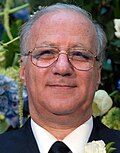Essam Eldin Khalil | |
|---|---|
 | |
| Born | Essam Eldin Khalil Hassan Khalil 12 July 1948 Scotland, United Kingdom |
| Died | 7 September 2022 (aged 74) Cairo, Egypt |
| Nationality | Egyptian |
| Alma mater | Cairo University |
| Awards |
|
| Scientific career | |
| Fields | Thermal power, combustion, environmental engineering and heat transfer |
Essam Eldin Khalil Hassan Khalil is an Egyptian mechanical engineer. Khalil is a professor in the mechanical power department at Cairo University. He is the author and co-author of several international researches in HVAC field. He has many years of experience in delivering courses in air-conditioning to University, college students, to building managers and maintenance staff in both the industrial and commercial sectors in Egypt, the Arabian countries and worldwide. [1] He has been selected by various universities and international organisations to lecture to graduate and post graduate level engineers, managers, supervisors and operating personnel on the subjects of HVAC design and optimisation, HVAC system management, energy utilization, waste heat recovery, plant management and other related subjects.
Contents
- Biography
- Academic accomplishments
- Continual contribution
- Awards and honors
- Books published in the field of Mechanical Engineering
- References
- External links
Khalil is ASME, AIAA and ASHRAE active fellow and is an ASHRAE distinguished lecturer on two topics; Ventilation of tombs of valley of kings and design of air conditioning systems for surgical operating theatres. The tombs include King Tutankh Amen, Ramses VII, Amhotep, Horemoheb, Ramses IV,V as well as Bay. It also includes the design of Air conditioning of the Hanging Church of Christ in Cairo.
Khalil is also the chairman of National HVAC Committee in Egypt, member of the National Energy Code Committee of Egypt and the chair of HVAC sub-group. He is a registered HVAC consultant and the president of the Arab Air Conditioning Code Committee. Khalil is the Convenor of ISO TC205 WG2 (Design of Energy Efficient Buildings) and is an active member of ISO TC163 Committee. He is the Chairman of Consulting Engineering Bureau, CEB.